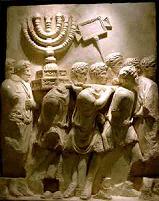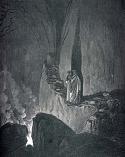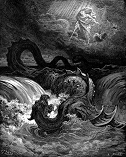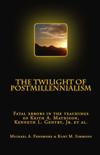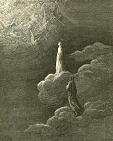Christ's Coming: Jewish or Universal?
In the almost 25 years I have been a Preterist, my understanding of the eschaton has grown and changed. In the early years, it was natural to view Christ’s eschatological coming almost exclusively in terms of God’s judgment upon the Jews and the end of the temple service and Mosaic law. With time, I began to widen my study to take account of troublesome passages that seemed outside the scope of Jerusalem’s fall – for example, passages that spoke of a time of judgment upon the whole world and epistles to Gentile churches admonishing them to “watch” and “wait.” Although difficult to fit into the picture as I then saw it, I felt sure such passages could not contradict the basic premise that Christ’s coming occurred in the events culminating in the destruction of Jerusalem. I am happy to report that that conviction remains firm and is now more certain than ever. However, bringing those passages within the scope of my understanding has forced me to broaden my view of the eschaton, so that while I still see it as being fulfilled by A.D. 70, I now see it as world-wide, and not merely Jewish in scope.
The Latter Days of What?
The term “eschaton” means “last things” and speaks to the time when God would bring to completion his great work of redemption. In the Holy Scriptures, this period is often designated by the phrase “last” or “latter” days. Because of their place in the divine economy as God’s chosen people through whom to bring the Saviour into the world, the Jewish nation figures prominently in prophetic passages concerning the latter days. However, the national election of the Jews was merely provisional – a temporary arrangement to accomplish a particular purpose. When that purpose was fulfilled, the Jews’ special place in the plan of redemption terminated. Moreover, because they were the murderers of Christ, and obstinately rejected the gospel and persecuted the church, their nation was destroyed. As might therefore be expected, this destruction figures prominently in the prophets’ writing about the latter days, and has caused many to see the eschaton exclusively in terms of its Jewish aspect: For example, Eusebius explained Jacob’s prophecy (Gen. 49:1ff) of what would befall the tribes of the Jews in the last days thus:
“For we must understand by ‘the end of the days’ (viz., “the last days,” LXX) the end of the national existence of the Jews. What, then, did he say they must look for? The cessation of the rule of Judah, the destruction of their whole race, the failing and ceasing of their governors, and the abolition of the dominant kingly position of the tribe of Judah, and the rule and kingdom of Christ, not over Israel but over all nations, according to the word, ‘This is the expectation of the nations.’”[1]
In defining the latter days exclusively in terms of the destruction of the Jewish polity, Eusebius makes a mistake common among Preterists – one that until recently I made myself. The error in this approach is that it fails to see that more lines intersected in the eschaton that the fall of Jerusalem; other enemies had to be put beneath Christ’s feet than merely the Jews. Paul makes this clear when he says, “For he must reign, till he hath put all enemies under his feet.” (I Cor. 15: 25; emphasis added) The universal nature of Christ’s rule is also affirmed by the Psalmist when he says “thou hast put all things under his feet.” (Ps. 8:6, emphasis added; cf. Heb. 2:8) In another place, the Psalmist extends Christ’s rule to all nations:
Ask of me and I shall give thee the heathen for thine inheritance, and the uttermost parts of the earth for thy possession. Thou shalt break them with a rod of iron; thou shalt dash them to pieces like a potter’s vessel. Ps. 2:8, 9
These passages are essentially eschatological and speak to Christ’s kingdom coming in power against his enemies. Psalm two in particular is about the murder of Christ, his ascension, and vengeance upon both Jews and Romans. Psalm one hundred ten is to the same effect:
The Lord at thy right hand shall strike through kings in the day of his wrath. He shall judge among the heathen, he shall fill the places with the dead bodies; he shall would the heads over many countries. Ps. 110:5, 6
These passages clearly contemplate more than the fall of Jerusalem; all nations are spoken of as coming within the sweep of Christ’s eschatological judgment. Nor are these are not the only verses that affirm Christ’s universal coming. There should be added to these Nebuchadnezzar’s dream of the latter days, in which the Stone smote the inhabited world embodied in the Roman empire, reducing to shivers the world of man. (Dan. 2:28-45) I challenge anyone to make Daniel two fit within the compass of the destruction of Jerusalem. And what of Daniel chapter seven? The Jews are not so much as even mentioned. Yet, Christ is depicted coming in vengeance upon the fourth world empire (Rome), symbolized by the beast, and upon Nero, the little horn that made war upon the saints. (Dan. 7:22-27) These and other verses, by their express terms, bring within Christ’s eschatological judgment nations far removed from Jerusalem.
These are just a few of the Old Testament passages showing the eschaton was world-wide. The New Testament also abounds with passages showing the universal nature of Christ’s eschatological coming. For example, in Acts 17:3 Paul addressed the Athenians, saying, “Because he hath appointed a day, in the which, he is about to judge the world in righteousness by that man whom he hath ordained; whereof he hath given assurance unto all men, in that he hath raised him from the dead.” The term rendered “world” here is oikoumenen, and is defined as the inhabitable world, or Roman empire. Clearly, Paul was warning the Athenians about something more than the destruction of Jerusalem. Another example is seen II Thessalonians 2:8 - the companion text to Daniel 7:22-27 and the destruction of the little horn – which plainly states that Jesus would destroy the man of sin (Nero) with the breath of his mouth and the “brightness of his coming.” Hence, Nero’s death in A.D. 68 is attributed by Paul to Christ’s eschatological coming in vengeance upon the persecutors of his church. Need it be pointed out that Nero did not live in Jerusalem?
These and other passages all prove that the eschaton was world wide and not merely Jewish or covenantal. This leads to an important point. When Preterists encounter phrases such as “the end of the aenon” (world or age) (Matt. 24:3) or this “evil aenon” (Gal. 1:4), we typically have interpreted this to mean the end of the Mosaic age. We do this same thing with the phrase “last” or “latter” days, which we interpret to mean latter days of the Mosaic age or national Israel. But, just as the latter days spoke to more than the fall of Jerusalem, so the world that passed at the eschaton was more than merely Mosaic. Paul told the Corinthians “the fashion of this world (Gk. kosmos) passeth away.” (I Cor. 7:31) The world of the Corinthians – like the rest of ancient man, including the Jews - was not fashioned or defined by the Mosaic law. The temple ritual and Mosaic law were indicative of a larger, all-pervading reality; a reality the law and temple ritual were created in response to, but did not themselves make. Rather, the one thing that defined the world condition more than anything else was the universal reign of sin and death. This was the enemy Christ ultimately came to destroy, not the Jews or Romans. The Jews and Romans came under wrath only because they took the part of sin and death by opposing the gospel. Otherwise, Christ had no inherent account to settle with them. Thus, when Paul said that the fashion of the world was passing away, it was to a world languishing under the dominion of sin and death he alluded to, not the Mosaic age. The latter days described, not the end of the Mosaic age, but the end of the universal epoch marked by the reign of sin and death, the world order that had obtained from the time of mankind’s fall. The destruction of Jerusalem coincided with this event, but did not define it.
The Law of Sin and Death
In any discussion of this kind, it is important to take account of the universal nature of the law of sin and death and that mankind’s salvation lay in redemption from it, and not from the Mosaic law, as some Preterists have supposed. The law of sin and death was in force from the time God made man and placed him in the garden. God’s instruction to Adam not to eat from the tree of knowledge of good and evil carried with it the sanction of death for its transgression: “For in the day thou eatest thereof thou shalt surely die.” (Gen. 2:17) There are no fewer than five types of death that may be identified in the scriptures: 1) moral and spiritual, 2) legal and juridical, 3) physical, 4) hadean, and 5) eternal death. Moral and spiritual death speaks to mankind’s inherent fallenness, the moral depravity that besets the whole race due to Adam’s transgression. Juridical death speaks to the legal censor and sentence of death pronounced upon all that transgress God’s law. Paul alludes to juridical death when he says, “And you hath he quickened, who were dead in trespasses and sins.” (Eph. 2:1) That is, God had acquitted them of their sins and the penalty of death, and made them heirs of life.
Whatsoever is not of faith is sin. (Rom. 14:23) This means that sin is tied to man’s moral faculties of faith and conscience, exculpating infants and idiots from guilt. From the time he arrives at the age of accountability, man lives under the sentence of juridical death for his sins. Unless he is saved from his sins, and receives pardon by obedience to the gospel, at the time of physical death man’s fate is fixed and the sentence of eternal death awaits him. However, prior to the eschaton, man’s spirit was kept in hades; thus, the origin of hadean death. This was necessary so that the souls of the righteous might be kept in safety until Christ could accomplish the work of his cross, making redemption for their sins. It is to the souls of the just in hades paradise that John refers in Revelation when he says he saw the souls of them beheaded for the gospel, living and reigning with Christ. (Rev. 20:3-6) The wicked were also kept in hades tartarus until the judgment of the last day, when they were cast into the lake of fire, which is called the “second death” (eternal death). (Rev. 20:11-15; cf. I Pet. 3:19; II Pet. 4:2)
The point that needs to be made here is that death came into the world independent of Mosaic law. The reign of sin and death was universal; all men were under its power, both Jew and Gentile. Bringing in the Mosaic law did not create mankind’s bondage, nor would taking away the Mosaic law deliver him from it. The Mosaic law was superimposed upon the law of sin and death; its ordinances merely served to demonstrate man’s condition, which obtained from the time of the race’s fall in the garden. Paul said “The law entered that the offence might abound.” (Rom. 5:20) That is, the Mosaic law did not create the offence, it merely magnified it; it served to teach man about his bondage to the law of sin and death, and the hopelessness of his condition apart from the substitutionary death and atoning sacrifice of Christ. Proof of this is seen in the fact that the Mosaic law is no longer in force today, yet all who are not in Christ are under bondage to the law of sin and death. Moreover, the Gentiles were never under the law of Moses, but they were under bondage to sin and death, and every bit as much in need of salvation as the Jews. It was to Gentiles Paul wrote when he said “And you hath he quickened, who were dead in trespasses and sins” (Eph. 2:1) - juridically dead in sin, even though not under the law of Moses.
Paul makes express mention of the law of sin and death in his letter to the Romans:
For the law of the Spirit of life in Christ Jesus hath made me free from the law of sin and death. For what the [Mosaic] law could not do, in that it was weak through the flesh, God sending his own Son in the likeness of sinful flesh, and for sin, condemned sin in the flesh. Rom. 8:2, 3; emphasis and bracketed matter added.
Notice that two laws occur in this passage: 1) the law of sin and death and 2) the law of Moses. The Jews thought that perfection came by the Mosaic law, but Paul shows that it could not deliver from the law of sin and death. This is because man can never rise completely above his flesh, but lives under condemnation of the moral and spiritual law he is bound to transgress. Moreover, the law of Moses made no provision for redemption (the blood of bulls and goats could never take away sins, Heb. 10:4): “For the law made nothing perfect, but the bringing in of a better hope did, by which we draw nigh to God.” (Heb. 7:19) A little earlier, Paul identified the law of sin and death with the law of man’s inherent fallenness in this passage:
For I delight in the law of God after the inward man: but I see another law in my members, warring against the law of my mind, and bringing me into captivity to the law of sin which is in my members. O wretched man that I am! Who shall deliver me from the body of this death? I thank God through Jesus Christ our Lord. Rom. 7:22-24; emphasis added.
In this passage, the “law of God” that delights the inward man is the moral and spiritual law. Violation of the moral and spiritual law brings man under the law of sin and death. Like the law of sin and death, the moral and spiritual law exists independent of the Mosaic law. Although much of the moral law was codified by the law of Moses, it did not derive its force from it, and it continues to exist today even though the Mosaic law has passed away. The “law of sin in my members” refers to the elemental forces of man’s inherent fallenness. The Spirit and Inspiration that God breathed into our first ancestor that enabled him to live above his flesh, was lost to Adam and his descendants through sin. Man is now “carnal, sold under sin.” (Rom. 7:14) It is impossible that he ever live completely above his flesh, even though he aspires to do so. Hence, Paul’s lament “O wretched man that I am, who shall deliver me from the body of this death.” Paul is not seeking physical death in this verse, for physical death without redemption is eternal damnation. Rather, Paul is expressing the impossibility of ever achieving salvation under the moral and spiritual law. No matter how much man might aspire to the moral and spiritual law, the law of sin in his members brought him into captivity to the law of sin and death. However, Paul expresses his thankfulness for the redemption in Jesus when he says “I thank God through Jesus Christ our Lord.” Since man’s problem laid in the universal law of sin and death, it should be clear that an exclusively “Jewish” eschaton would avail man nothing; something more had to be taken out of the way than the Mosaic law.
The Veil Spread Over all Nations
Although the main thrust of Paul’s letter to the Romans is to show Jews the futility of the Mosaic law for soteriological perfection, Gentiles were equally under bondage to the law of sin and death. Paul speaks to this in chapter eight, as follows:
For the earnest expectation of the creature waiteth for the manifestation of the sons of God. For the creature was made subject to vanity, not willingly, but by reason of him who hath subjected the same in hope, because the creature itself also shall be delivered from the bondage of corruption into the glorious liberty of the children of God. For we know that the whole creation groaneth and travaileth in pain together until now. And not only they, but ourselves also, which have the firstfruits of the Spirit, even we ourselves groan within ourselves, waiting for the adoption, to wit, the redemption of our body. Rom. 8:19-23
The “creature” is the whole of humanity, which was subjected to vanity by its inherent fallenness and the impossibility of obtaining salvation by any means it could devise. “Not only they” refers to the Gentiles; “ourselves also, which have the firstfruits of the Spirit” refers to the Jews. The Jews were the firstfruits to God and the Lamb. (Rev. 14:4; cf. Jm. 1:18; Eph. 1:12, 13) Sin and death reigned from Adam to Moses (Rom. 5:14); the whole creation - both Jew and Gentile - groaned and travailed in pain together under the bondage of corruption (the law of sin and death), looking for the glorious liberty of the sons of God (resurrection) promised our first ancestor in the garden - the promised Kinsman Redeemer that would bruise the head of sin and death through the power of his cross and resurrection and bring the adoption of sonship to those obey his gospel.
What this means in terms of the eschaton is that mankind’s deliverance from bondage to sin and death could never be accomplished by merely removing the Mosaic law. Hence, the age that concluded at the eschaton was not the Mosaic age - a phrase that never occurs in the Bible, but which Preterists have imposed upon it due largely to Matt. 24:3 and the apparent connection between the end of the “aenon” and the destruction of Jerusalem – not the end of the Mosaic age, I say, but the world-age (ton aiona tou kosmou-toutou, Eph. 2:1) marked by the reign of sin and death. Isaiah speaks to this when he says
And he will destroy in this mountain the face of the covering cast over all people, and the veil that is spread over all nations. He will swallow up death in victory; and the Lord God will wipe away tears from off all faces; and the rebuke of his people shall he take away from off all the earth: for the Lord hath spoken it. Isa. 25:6-8; emphasis added
The “veil spread over all nations” was not the Mosaic law, but the bondage of sin and death rising in man’s inherent fallenness, and the sentence of death that transgression of the moral law brings. This was the veil that separated man from God. The time for the promised deliverance began at the cross - when the veil of the temple was rent in twain - but finally accrued to the saints’ benefit at the resurrectoin, when the last enemy was destroyed. Paul refers to this as the “redemption of the purchased possession.” (Eph. 1:14) The “purchased possession” was eternal life; the price of its redemption was paid at the cross. The earnest-money given in token or seal (evidence) that God would complete the transaction was the inward groaning of the believer, longer for immortality. The redemption came when death delivered up its hoard. We might ask at this point if the fall of Jerusalem could accomplish all this? Not at all. The temple and veil stood in testimony to mankind’s universal banishment from the presence of God (Gentiles worshipped there too) and the need of an Intercessor to make peace through the sprinkling of blood. In terms of God’s promise to bring salvation to all mankind, its destruction did not mark the end of anything uniquely Jewish. Rather, it spoke to the end of the veil cast over all nations from the time of Adam’s fall.
The Little Apocalypse and Elements of the World
In the usus loquendi of the prophets, cataclysmic language in which the elements of nature are dissolved spoke to God’s judgment upon nations, not the dissolution of the earth and its elements. The language is hyperbolic and poetically exaggerated to emphasize the universal destruction coming upon the nations of the earth, but not the earth itself. Isaiah’s prophecy of Edom’s fall to the Babylonians makes the point:
Come near, ye nations, to hear; and hearken, ye people: let the earth hear, and all this is therein; the world, and all things that come forth of it. For the indignation of the Lord is upon all nations, and his fury upon all their armies: he hath utterly destroyed them, he hath delivered them to the slaughter. Their slain also shall be cast out, and their stink shall come up out of the carcasses, and the mountains shall be melted with their blood. And all the host of heaven shall be dissolved, and the heavens shall be rolled together as a scroll: and all their host shall fall down, as the leaf falleth off from the vine, and as a falling fig from the fig tree. Isa. 34:1-4
Identical language to this occurs in the New Testament regarding the eschaton. (Matt. 24:29; Lk. 21:25; 24: II Pet. 3:7-12) Hence, there is much we can learn from it. Foremost for present purposes, this passage is not confined to Idumea as Preterists sometimes assert. Although obviously the elements that would be dissolved were not the chemical or atomic elements of the earth, it is equally clear that more than Idumea was involved. All nations would come within the sweep of judgment that God was bringing upon the world through the Assyrians and Babylonians; the Idumeans were merely one nation involved in a time of universal wrath upon the world of man. The “little apocalypse” of Isa. 24-29, which Preterists are sometimes guilty of applying only to Judah and Israel, describes this same judgment. It is often overlooked that in the nine preceding chapters, the prophet describes God’s judgment upon Moab (Isa. 15, 16), Syria and Israel (Isa. 17), Ethiopia (Isa. 18), Egypt (Isa. 19, 20), Babylon, Dumah and Arabia (Isa. 21), Judah (Isa. 22), and Tyre. (Isa. 23) Thus, the judgment spoken of in the little apocalypse was world-wide; chapter twenty-four merely summarizes the judgments that overtook the ancient world in the preceding chapters.[2]
God’s judgment in carrying the Jewish nation into captivity under the Assyrians and Babylonians was typical of the eschatological judgment under Rome when the nation would suffer ultimate and irrevocable destruction. Hence, prophecies of the coming salvation and wrath under the Messiah are interwoven throughout the little apocalypse, showing it has a secondary meaning or fuller sense (plenior sensus in the terminology of theologians), which looked to the days of Christ. (Cf. Isa. 25:8; 26:19; 28:16-22) Like Isaiah, the apostle Peter wrote of the coming eschatological judgment under the Messiah. II Pet. 3:7-13 speaks of the dissolution of the heavens and earth, but, as we have seen, this language never contemplates the chemical components of the universe. The hermeneutic established by the prophets governs our interpretation; we cannot depart from it without clear evidence of God’s intent that we are so to do. Indeed, Peter’s reference to Isaiah’s promise of a “new heavens and earth” makes certain that the physical elements are not view. (See discussion, below.) However, just as more was involved in the little apocalypse than the Jews, so more is involved in II Peter than Jerusalem. As the judgment of the little apocalypse by Assyria brought within its sweep the whole world of ancient man, so Christ’s eschatological judgment would not be limited to Jerusalem and Palestine. All men would feel the rod of Christ’s correction as he meted out judgment and prepared to remake the world in greater conformity with his kingdom and gospel.
The New Heavens and Earth: Not the New Testament
After the desolations of the world by the Assyrians and Babylonians, God promised a time of renewal. The cities that lay waste would be rebuilt and the desert blossom like the rose as men again filled the earth and Israel returned to their land and brought it under cultivation. (Cf. Amos 9:9-15) The return from captivity was a type of the “restoration of all things” (Acts 3:21) that would be accomplished in Christ. The new heavens and earth promised by Isaiah (Isa. 65:17; 66:22) and mentioned by Peter and John (II Pet. 3:13; Rev. 21, 22) however, are not the New Testament as Preterists have sometimes supposed. The new Jerusalem is the covenantal habitation of the saints, not the new heavens and earth. Foy E. Wallace Jr., who, perhaps more than any other man, deserves the title as the “father” of modern Preterism for his work in the early twentieth century, refuting Premillennialism in the churches of Christ, says this about the new heavens and earth:
The new heaven and earth, and trouble[d] sea, having passed away and represented as being no more, indicated the changed conditions within the existing governments and society to make them favorable for the prosperity of the cause of Christ and his church throughout the empire…the vision represented the new conditions to surround the church in the changed world.[3]
Thus, according to Wallace, the new heavens and earth simply spoke to the world after the eschatological judgments and persecutions had ceased, in which the church emerged victorious with Christ. There can be no clearer proof that this is so, and that the new heavens and earth are not the New Testament, than the fact that the wicked inhabit them outside the city:
For without are dogs, and sorcerers, and whoremongers, and murderers, and idolaters, and whosoever loveth and maketh a lie. Rev. 22:15
The new heavens and earth speak to the world after the eschatological judgments of the last days were past, when the saints reign with Christ through the gospel. Like leaven folded within dough, the gospel message would breed and grow until it filled the world and every institution of man bore its imprint. However, the point we want to make at present is that, as the new heavens and earth are not the new covenant, so the old heavens and earth that passed at the eschaton spoke to more than Jerusalem and Jewry. The elements that would burn with fervent heat were not the furniture of the temple cultus or the law of Moses, but the elements of the social and political environment making up the pre-parousia world. The picture of Revelation twenty-one and twenty-two is the church in the world victorious, not the church in the world minus merely the Jews or the law of Moses. The elements consumed at the eschaton included the Jewish polity and nation, yes; but were by no means limited to them.
Conclusion
The early days of the modern Preterist movement confronted us with themes that were unfamiliar. We correctly assessed that the eschaton was an event of the past, which occurred within the lives of the apostles. However, we tended to interpret it in overly narrow, purely Judaistic terms. Hopefully, we are beginning to see that its judgments were world wide and not at all limited to Palestine.
[1] Eusebius, Demonstratio Evangelica, VIII, ccclxxv; Ferrar ed.
[2] It is possible that the devastations described reach to the Persian empire inasmuch as the day of the Lord against Babylon by the Medes is spoken of in chapters 13 and 14, immediately preceding the catalogue of nations surveyed from chapters 15-23.
[3] Foy E. Wallace, The Book of Revelation (1963, Wallace Publications, Ft. Worth), p., 426.
To receive Kurt Simmons’ e-mail newsletter, The Sword & The Plow, click the Subscribe link:
All rights reserved.
